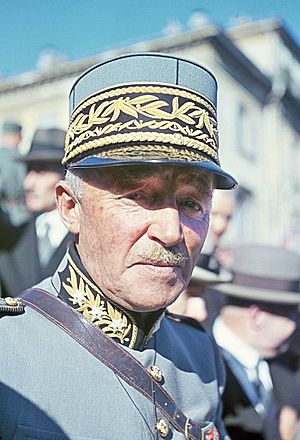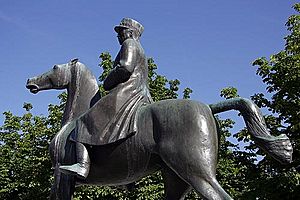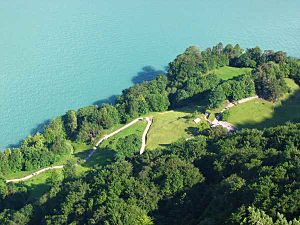Henri Guisan facts for kids
Quick facts for kids
Henri Guisan
|
|
|---|---|

in Visp, 1942
|
|
| Born | 21 October 1874 Mézières |
| Died | 7 April 1960 (aged 85) Pully |
| Allegiance | |
| Service/ |
Artillery |
| Years of service | 1894–1945 |
| Rank | |
| Commands held | Swiss Armed Forces |
| Battles/wars | Second World War (not directly involved) |
Henri Guisan ( 21 October 1874 – 7 April 1960) was a Swiss army officer who held the office of the General of the Swiss Armed Forces during the Second World War. He was the fourth and the most recent man to be appointed to the rarely used Swiss rank of general, and was possibly Switzerland's most famous soldier. He is best remembered for effectively mobilizing the Swiss Armed Forces and Swiss people in order to prepare resistance against a possible invasion by Nazi Germany in 1940. Guisan was voted the fourth-greatest Swiss figure of all time in 2010.
Family and career
Henri Guisan was born in 1874 in Mézières, in the canton of Vaud, a Protestant part of French-speaking Switzerland. The son of Charles Ernest Guisan, a doctor from Avenches, and Louise-Jeanne Guisan, he attended school in Lausanne and Fribourg, and initially studied agricultural medicine. Upon completing his studies, in 1897, he moved to and became a gentleman farmer in the Broye Valley. That same year, he married Mary Doelker, with whom he would have two children, Henry and Myriam. Soon after marrying Mary, he moved to Verte-Rive on Lake Geneva.
Early military service
Upon entering the Swiss military in 1894, he was assigned to a horse-drawn artillery unit in Bière as a lieutenant. He was promoted several times, reaching the rank of captain in 1904, colonel in 1920, brigadier in 1927, and corps commander In 1932.
General

On 28 August 1939, a Federal Assembly called a United Federal Assembly to elect a general: a unique rank chosen only in time of war or national emergency. On 30 August 1939, Guisan was elected as general, by 204 votes to 21 for Jules Borel. He was given the directive to safeguard the independence of the country and to maintain the integrity of Swiss territory. In 1939 the Swiss military were able to muster 430,000 men, approximately 20% of the work force. At one point, up to 850,000 Swiss soldiers were mobilized. However, Swiss military equipment was not on a par with that of the German military.

Guisan's appointment came despite his membership in the Fédération patriotique suisse, an organization supportive of cordial relations with Nazi Germany. However, his command was dominated by conflict with the government, and with the politicians continually airing German and French sentiments. Whereas the government preferred an understated and politically riskless neutrality, Guisan, charged with actually preventing invasion, opted to call for determined resistance. After the Battle of France, Germany found documents proving that Guisan had been secretly making military preparations with France, despite Swiss neutrality. The Swiss military would have been remiss in not pursuing contacts with the French based on their perception of a German threat. Nonetheless, this was politically very risky, and represented a very typical example to be seized upon by Germany to justify aggression, such as occurred prior to the German invasion of the Netherlands in World War II.
On 25 July 1940, Guisan delivered a historic address to the entire Swiss Officer Corps assembled on the Rütli, a location charged with symbolism in Swiss Romantic nationalism by virtue of being identified as the site of the Rütlischwur of 1291. Guisan became a symbol of resistance to Nazism that was widespread amongst the Swiss public.
He made it very clear that Switzerland would resist any Nazi invasion. If they ran out of bullets they were to resort to the bayonet. He said that Switzerland would defend itself against any invader and would never surrender. The Swiss government had a decentralised structure, so even the Federal President was, and still is, a relatively powerless official with no authority to surrender the country. Indeed, Swiss citizens had been instructed to regard any surrender broadcast as enemy propaganda and resist to the end.
As a consequence, Guisan developed his famous Réduit National concept in summer 1940, according to which the Swiss Army would have retreated into the Alps relatively soon if attacked, but would have kept up resistance based on some sort of guerrilla and stay-behind tactics from there. The Swiss paramilitary organization Aktion Nationaler Widerstand (Resistant National Action), formed from contacts between selected army figures and conservative civilian circles, had the explicit task of persuading the civilian population to resist invaders.
However, Guisan's and Switzerland's main strategy was deterrence rather than fighting, and Germany never risked invasion. On 20 August 1945, Guisan left his command, considering his mission to be fulfilled.
Having become a national hero by successfully avoiding war, Guisan died in Pully on 7 April 1960. He was buried on 12 April 1960 in Pully cemetry, with 300,000 participating in his funeral march through Lausanne. His grave is a work by Edouard-Marcel Sandoz.
Public image
In his life, Guisan heavily propagandized his public image, banning 5,600 images of himself from being printed from 1939 to 1945. Guisan also held several symbolic actions, such as the Rütli Report. In Switzerland, Guisan was an extremely popular figure. He has been criticized for admiring Benito Mussolini and Philippe Pétain as well as having a secret meeting with Walter Schellenberg in March 1943.
Memorials
Guisan's former home Verte Rive in Pully is now used as Centre Général Guisan. His office, living room and dining room are preserved as a museum.
Memorials are at:
- Lausanne-Ouchy: equestrian statue by Otto Bänninger, financed following a public fundraising in 1960, inaugurated on 27 May 1967 in the presence of 70,000 people
- Avenches: a bust, inaugurated in 1969
- On the main deck of the steamship Stadt Luzern: a memorial plaque with his relief by Franco Annoni commemorating his speech on Rütli in 1940, inaugurated by Georges-André Chevallaz in 1980, 40 years afterwards
- Library am Guisanplatz, Bern: equestrian sculpture by Laurent Boillat, created in 1949 and installed in September 2008
- Powązki Cemetery, Warsaw, Plaque: plaque inaugurated in 2010
- Schlossgarten, Interlaken: monumental sculpture
- Allmend, Zollikon: memorial with a relief
- Lägern above Regensberg: memorial plaque
- Dentenbergstrasse, Gümligen/Muri bei Bern: Memorial
- Victoria-Jungfrau, Interlaken: plaque in the hotel
- General-Guisan Quai, Lucerne: plaque on the lakeshore
Numerous cities and towns in Switzerland have streets named for him: General Guisan-Strasse in Aarau, Arlesheim, Basel, Forch, Nussbaumen, Obersiggenthal, Reinach, Seltisberg, Winterthur, Zofingen, Zug; General Guisanstrasse in Interlaken, Jegenstorf, Leuggern; Guisanstrasse in Burgdorf, St. Gallen, Weinfelden; avenue Général-Guisan in Avenches, Fribourg, Pully, Rolle, Sierre, Vevey, Yverdon-les-Bains; rue du Général Guisan in Courroux, Mézières, Montana; Promenade Général Guisan in Morges; General Guisan-Promenade in Basel; via Henri Guisan in Bellinzona; via Generale Guisan in Balerna, Biasca, Riva San Vitale, Vacallo, Lugano; via Generale Henri Guisan in Chiasso; via Guisan in Massagno, Paradiso; Via Enrico Guisan in Mendrisio
Town squares and open spaces are named after him: Guisanplatz in Arosa, Berne, Grenchen and Thun; Guisanplatz/Place Guisan in Biel/Bienne; place Général-Guisan in Payerne and Pleigne; place du Général Henri-Guisan in Lausanne.
There is a quai du Général-Guisan on Lake Geneva in Geneva, General-Guisan-Quai on Lake Lucerne in Lucerne and Stansstad, on Lake Zurich in Zurich.
A military march titled "General-Guisan-Marsch" was composed in 1939 by Stephan Jaeggi.
Asteroid 1960 Guisan has been named in Guisan's honour.
The manga Alpen Rose by Michiyo Akaishi gives Guisan an important role in the story.
See also
 In Spanish: Henri Guisan para niños
In Spanish: Henri Guisan para niños




